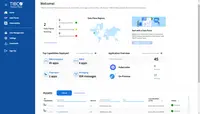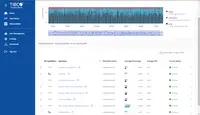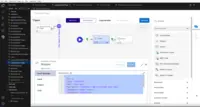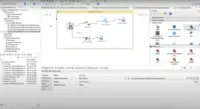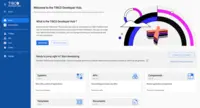TIBCO Integration (including BusinessWorks and Flogo)
Overview
What is TIBCO Integration (including BusinessWorks and Flogo)?
TIBCO Integration is used to connect diverse business solutions, data sources, and devices into a single, seamless system.
Broaden your horizon with Scribe
The Best integration tool in the world.
A good project accelerator
Could be better, does some of the jobs, but gets frustrating for API calls. Documentation is also too generic and they need recipes.
Stay tuned on data with TIBCO Businessworks!
TIBCO BUSINESSWORKS - More than just an Integration tool
Scribe Integration to Microsoft Dynamics GP
TIBCO Cloud Integration (including BusinessWorks and Scribe) at a glance!
Trust My Review
TIBCO Cloud Integration (including BusinessWorks and Scribe) is great!
TIBCO and Sales Order Process.
Empowering Seamless Integration with TIBCO Cloud Integration's Versatility and Performance
Seamless integration made easy
Reasons to use TCI
How TIBCO Integration (including BusinessWorks and Flogo) Differs From Its Competitors
TIBCO Platform Integration
TIBCO Platform Integration
Business Impact
Deployment
Flexibility
Reliability and Strength
Decision Factors
Cloud Benefits
TIBCO Investment Preservation
Future Proofing
Customer Feedback
Requirements
Future Use
TIBCO Cloud Integration Learning from the Community
TIBCO Platform Integration
Tasks Accomplished
Cloud Benefits
TIBCO Platform Integration
Little early to comment on the impact of …
TIBCO Products Used
Tasks Accomplished
Business Impact
Deployment
Flexibility
Reliability and Strength
Decision Factors
TIBCO Platform Integration
TIBCO Platform Integration
TIBCO Platform Integration
TIBCO Platform Integration
TIBCO Cloud Integration Impact
Lessons for Success
Cloud Benefits
Cloud Migration
TIBCO Investment Preservation
Future Proofing
Customer Feedback
Another really annoying thing: The mappings …
Requirements
Considerations
Future Use
Decision Factors
Recommendations
Deployment
Integrations
Integration Special Use case
TIBCO Cloud Integration Learning from the Community
TIBCO Cloud Integration Tips and Tricks
TIBCO Cloud Integration Favorite Features
2. Multiple agents: My solutions can connect to different agents on different on-premise systems. This speeds up the integration a lot
3. Lots of connectors: These are really helpful with most of the common data sources
TIBCO Cloud Integration Features You Wish You'd Used Sooner
TIBCO Cloud Integration Feature Differentiators
TIBCO Cloud Integration Impact
Lessons for Success
The most important lessons is that instead of writing custom tool / code which would take up more effort, time and cost, the organization should go with time-proven solution like TIBCO Cloud Integration for all the …
Cloud Benefits
Cloud Migration
TIBCO Investment Preservation
Future Proofing
Customer Feedback
Requirements
TIBCO Cloud Integration Impact
Lessons for Success
Lessons for Success
TIBCO Cloud Integration Impact
Lessons for Success
TIBCO Cloud Integration Impact
Lessons for Success
TIBCO Cloud Integration Impact
Lessons for Success
TIBCO Cloud Integration Impact
TIBCO Cloud Integration Favorite Features
We further developed in-house integrations for digital strategies
Also, helped us maintain some mission-critical applications
TIBCO Cloud Integration Feature Differentiators
TIBCO Cloud Integration Impact
Integration Special Use case
TIBCO Cloud Integration Onboarding Wisdom
TIBCO Cloud Integration Learning from the Community
TIBCO Cloud Integration Tips and Tricks
Create a job to actually delete the target records marked as 'Deleted'.
TIBCO Cloud Integration Favorite Features
TIBCO Cloud Integration Features You Wish You'd Used Sooner
TIBCO Cloud Integration Impact
The map customization is fairly …
Lessons for Success
TIBCO Cloud Integration has allowed us to successfully and smoothly integrate data between multiple disparate systems.
The most important lesson I've learned is to keep things simple. While the integration process is very easy to follow, it's important to keep configurations simple because you may …
Decision Factors
Recommendations
Deployment
Integrations
Integration Special Use case
TIBCO Cloud Integration Onboarding Wisdom
TIBCO Cloud Integration Learning from the Community
TIBCO Cloud Integration Tips and Tricks
TIBCO Cloud Integration Impact
Lessons for Success
We learned that sometimes Tibco Scribe is not up to date when it comes to changes in the REST api or changes Microsoft implements on the database, which caused the …
Decision Factors
Recommendations
And the relationship the …
Deployment
Integrations
Integration Special Use case
TIBCO Cloud Integration Onboarding Wisdom
But also be prepared to …
TIBCO Cloud Integration Learning from the Community
So to be honest I've got very little experience with the Tibco Community, on the other …
TIBCO Cloud Integration Tips and Tricks
This is one aspect users of the …
TIBCO Cloud Integration Favorite Features
TIBCO Cloud Integration Impact
Decision Factors
Recommendations
TIBCO Cloud Integration Impact
The revisions functionality has also made rolling back really good.
Decision Factors
Needs to be competitive for our customers when going up against other products.
Deployment
Integration Special Use case
TIBCO Cloud Integration Onboarding Wisdom
Know your scenarios, know your systems data structure and you will pick it up
TIBCO Cloud Integration Learning from the Community
TIBCO Cloud Integration Feature Differentiators
And its reliability
Decision Factors
Prices were negotiated, since we were loyal tibco customers.
Also TIBCO Cloud simplifies the way data are captured, applications connect, and turn …
Deployment
- A highly available architecture
- A VPC configured with public and private subnets according to AWS best practices
- An Internet Gateway to allow access to the WEB
- In public subnets, NAT Gateways managed to authorize outgoing …
Integrations
- AWS CloudWatch Logs
- AWS ECR Repository
- AWS S3 bucket
TIBCO Cloud Integration Favorite Features
2- The Drag and Drop feature that easily allow developer to create flow, parse messages, and perform complex mapping.
3- The software is very user friendly.
TIBCO Cloud Integration Features You Wish You'd Used Sooner
TIBCO Cloud Integration Feature Differentiators
TIBCO Cloud Integration Impact
Deployment
Integrations
TIBCO Cloud Integration Favorite Features
- Consistent scheduled jobs that run and alert you if any issues.
- The jobs just run and do so consistently. You don't have to worry if it is working properly or if any data isn't making it into your source system.
- Flexibility of connecting to nearly any system.
- Being able to connect to a REST API or …
TIBCO Cloud Integration Features You Wish You'd Used Sooner
TIBCO Cloud Integration Feature Differentiators
TIBCO Cloud Integration Impact
Lessons for Success
TIBCO Cloud Integration Impact
Awards
Products that are considered exceptional by their customers based on a variety of criteria win TrustRadius awards. Learn more about the types of TrustRadius awards to make the best purchase decision. More about TrustRadius Awards
Popular Features
- Pre-built connectors (120)7.575%
- Support for real-time and batch integration (117)7.070%
- Monitoring console (120)6.969%
- Connector modification (8)5.555%
Reviewer Pros & Cons
Pricing
What is TIBCO Integration (including BusinessWorks and Flogo)?
TIBCO Integration is used to connect diverse business solutions, data sources, and devices into a single, seamless system.
Entry-level set up fee?
- Setup fee optional
Offerings
- Free Trial
- Free/Freemium Version
- Premium Consulting/Integration Services
Would you like us to let the vendor know that you want pricing?
Alternatives Pricing
What is Azure Logic Apps?
Microsoft offers the Azure Logic Apps as a cloud-based integration service, supporting data and application integration.
What is SAP Integration Suite?
SAP Integration Suite is an integration platform-as-a-service (iPaaS) that helps quickly integrate on-premises and cloud-based processes, services, applications, events, and data. It is used to accelerate innovation, automate more processes, and realize a faster time to value.
Features
Cloud Data Integration
Cloud data integration software simplifies the task of integrating data from multiple different cloud applications
- 7.5Pre-built connectors(120) Ratings
Pre-built, tested connectors to a wide variety of applications such as ERP, CRM, HCM, Marketing Automation, etc.
- 5.5Connector modification(8) Ratings
Provision for modification of pre-built connectors to suit specific environments
- 7Support for real-time and batch integration(117) Ratings
Software supports both real-time and batch integrations
- 5.5Data quality services(6) Ratings
Software includes capability to perform data profiling, deduplication, cleansing etc.
- 2.7Data security features(7) Ratings
Data security features include rights management, LDAP integration, password encryption, etc.
- 6.9Monitoring console(120) Ratings
Central console for monitoring resource utilization, system health, ability to start and stop processes, etc.
Product Details
- About
- Integrations
- Competitors
- Tech Details
- Downloadables
- FAQs
What is TIBCO Integration (including BusinessWorks and Flogo)?
TIBCO Integration is used to connect diverse business solutions, data sources, and devices into a single, seamless system. TIBCO accelerates connectivity initiatives with low and no-code experiences engineered to reduce development time and costs. Users can implement the best-fit style of integration to address any app, data, IoT, B2B and mobile/web integration use case. TIBCO Integration can connect to virtually any endpoint across the IT ecosystem with 200+ pre-built connectors for a wide variety of business suites, databases and legacy technologies.
TIBCO Integration (including BusinessWorks and Flogo) Features
Cloud Data Integration Features
- Supported: Pre-built connectors
- Supported: Support for real-time and batch integration
- Supported: Monitoring console
Additional Features
- Supported: No-code Business Process Automation
- Supported: No-code Graphical Designer
- Supported: Container and PaaS Support
- Supported: Enterprise Scale
TIBCO Integration (including BusinessWorks and Flogo) Screenshots
TIBCO Integration (including BusinessWorks and Flogo) Integrations
- Salesforce Sales Cloud
- HubSpot Marketing Hub
- Microsoft SQL Server
- Adobe Marketo Engage
- Microsoft Dynamics GP
- SAP ERP, ECC
- MySQL
- NetSuite ERP
- PostgreSQL
- Salesforce Marketing Cloud
- ServiceNow IT Service Management
- Shopify
- Google Analytics
- Jira Software
- Sage Intacct
- ON24
- Oracle Marketing
- Oracle Database (legacy)
- Sugar Sell (SugarCRM)
- Microsoft Dynamics 365 Business Central
- Microsoft Dynamics 365
- Microsoft Dynamics AX, discontinued
- Adobe Commerce (Magento Commerce)
TIBCO Integration (including BusinessWorks and Flogo) Competitors
TIBCO Integration (including BusinessWorks and Flogo) Technical Details
| Deployment Types | On-premise, Software as a Service (SaaS), Cloud, or Web-Based |
|---|---|
| Operating Systems | Windows, Linux, Mac |
| Mobile Application | No |
| Supported Countries | Global |
| Supported Languages | English |
TIBCO Integration (including BusinessWorks and Flogo) Downloadables
Frequently Asked Questions
Comparisons
Compare with
Reviews and Ratings
(502)Attribute Ratings
- 1Likelihood to Renew28 ratings
- 8.9Availability6 ratings
- 7.2Performance6 ratings
- 4.5Usability23 ratings
- 7.3Support Rating28 ratings
- 5.6Online Training3 ratings
- 1.3In-Person Training5 ratings
- 10Implementation Rating8 ratings
- 7.3Configurability5 ratings
- 7.8Product Scalability23 ratings
- 7.3Ease of integration21 ratings
- 7.3Vendor pre-sale4 ratings
- 7.3Vendor post-sale6 ratings
Reviews
(1-25 of 114)TIBCO user
- It is immediate thanks to the graphical interface
- Very useful for creating web services
- You can integrate many systems between them
- It can integrate cloud systems
- It should be more stable
- It should also be an open source version
- It should incorporate test data management, such as queues or database
- Add more plugins
Broaden your horizon with Scribe
- Integration abstraction
- Extensive ecosystem of connectors
- Management of integration and its dependency on vendor versions
- Ease of usage
- User friendly UI
- Granular security
- Improved monitoring and troubleshooting capability
- More out of the box templates
Could be better, does some of the jobs, but gets frustrating for API calls. Documentation is also too generic and they need recipes.
- data replication
- data sync
- API calls
- JSON Normalization
Stay tuned on data with TIBCO Businessworks!
- Access to real-time data across different environments.
- No need to know a specific language code.
- Expose multiple business processes as web methods under one service.
- Manage JDBC.
- Global Variables.
- SOAP over HTTP.
Scribe Integration to Microsoft Dynamics GP
- Offer integration for various modules of GP.
- Groups and alerts are easy to set-up.
- Initial configuration and installation are lengthy.
- Does not roll back all errors.
- Automation of development pipelines
- Use of microservices for Agile SDLC
- Automation of business process and workflows
- Still figuring out debugging
- Integration with other TIBCO tools can be a tedious task
TIBCO and Sales Order Process.
- The UI is easy to navigate and map flows are intuitive and easy to build upon after some basic training. However, a user should have some basic knowledge of writing nested statements.
- Very responsive customer support.
- The debug feature is a great tool for troubleshooting. You can easily identify where the issue is in your flow. At each debug step, it returns the expected value, and when there isn't the expected value, you know when to modify your flow.
- It seems to struggle with being able to query large data sets. It would error out when attempting to query about 15K customer accounts.
- Training. I had to look on the internet for some videos to understand how the control boxes work. When we initially installed TIBCO we received a crash course. You need someone with a good analytical, technical, or data background to use this tool.
- Error messages doesn't always match the issue causing the error.
Seamless integration made easy
- It's easy to use with user friendly graphical interfaces.
- It allows easy data transformation and mapping.
- It's offers pre-buikt connectors for popular applications.
- There isn't anything that I can think of that I would say I dislike. It is so easy to use and my experience using it has been great. I love using it, especially with other programs TIBCO offers.
Reasons to use TCI
- Security policies for authorization and authentication
- Error handling made easy
- Plugins to connect with systems
- Logging - providing a inbuilt log framework
- Feature to easily generate yaml files
Less appropriate if there are complex transitions and business logics to be implemented
TCI worth a try
- Transform data
- combine data from several sources
- retrieve data from different sources using SOAP or REST webservices
- debug facilities in BW6, more possibilities for detailed unit testing, testing xslts etc...
- use of eclipse makes it slow
- in BW5 internal xsds could be used so that not everything needs a separate xsd definition. This option is gone in BW6...
- There are bugs in the interface of FLOGO to load from the API modeler or load an API definition from a file, editing is cumbersome.
TIBCO means successful data migration/integration
- Integrations with different applications Workday, Single Sign-On,CertTracker,Okta,Partner contact sync and Questionmark is successful.
- TIBCO, successful Content ,data migration(courses, classes, registrations, transcripts etc.) ,User migration(Internal users and Partner migration)and Report migration
- LOD: Learn on demand is a third party vendor application where all Virtual classes are delivered by the vendor application. Learning management system sends the class and registration events to learn on demand via real time web service call through TIBCO
- Integrations with different applications Workday,Single Sign-On,CertTracker,Okta,Partner contact sync and Questionmark is successful.
Great for Dynamics CRM
- Easy integration, even for non-programmers
- It can connect to a lot of different systems/databases easily
- The support is helpful and questions are answered fast and professionally. And if nothing helps, you get remote live-support
- Good on-site training available
- It is fast and (the CRM module) has the ability to cache query results
- Export and import of mappings are very easy
- Easy change of connections in (imported) mappings
- The debugger is a pain. Sometimes it is hard to find an issue
- It is not possible to split the integrations into steps. You need to copy/paste (and maintain) integration-steps that are used in multiple integrations
- You cannot call a flow from another flow
- Scribe online helps support complex integration scenarios especially in case of XML structure with parent-child relationships.
- Scribe online interface is very user friendly and intuitive.
- It doesn't require any programming skills to implement to complex scenarios.
- We faced one issue with The XML Source component of Scribe Insight which wasn't not in the Scribe Online version. "Repeating nodes are not supported for cousins, siblings, etc. Multiple repeating nodes must be related linearly to repeating nodes that already exist. Thus, a new repeating node must be a grandparent, parent, child, grandchild, etc., to an existing repeating node." The product can be updated to include the repeating nodes support.
- Scribe Insights Interface can be updated and be made more user friendly - basically like the Scribe Online interface
- Cost is also one of the factor, usually, when it comes to Dynamics CRM/365 Integration most of the places, we have customers using KingswaySoft instead of Scribe.
- Connector towards Hubspot and MS CRM works good for Scribe.
- Incremental updates based off last run date.
- Building blocks in Scribe work fine.
- Annoying lockout of webapp during development.
- Error handling is not so informative.
- Help and support info is not the best.
- Functions, lookups and more technical features are not as good as SSIS.
Review
- Integration with internal systems.
- Integration with external systems.
- Rest API development.
- TIBCO support can be provided in a better way.
- Handling JSON transformation.
- Heavy weight.
Tibco Scribe, Dynamics CRM, and Dynamics GP
- Performs calculated data transformations on the fly.
- Schedules recurring jobs with great flexibility.
- Allows granular selection of notifications.
- User interface isn't as intuitive as it could be.
- Robustness
- Simplicity for designing solutions
- Ability to connect to multiple sources
- Easy to debug
- Easy to use drag and drop in Designer
- Integration with native self-built Java modules is difficult
- Can be less heavy on memory use
- Difficult for users with no IT experience
- Great UI
- Easy to build logic
- Easy datamapping
- Very reliable
- Integration templates for "standard use cases."
- Performance increase for large bulk jobs (average around 3 seconds per record but can be more).
- Licensing not based on solutions.
Great experience with Scribe Online integration
- Flexible scheduling of jobs for SQL server.
- Reliability of data copies from cloud to on-premise.
- Custom one-time jobs can also be created (both small and big) as per user requirements.
- On some occasions, the scheduled jobs fail due to technical glitches. This can be improved for better user experience.
Scribe Replication Service Issues
- Daily Replication succeeds without errors more often than not.
- The Replication Service does not include the ability to "pre-filter" the data in any way, i.e., it gets ALL records from the beginning of time and ALL columns, many of which are not used in CRM.
- Several errors with records that fail to be processed are frequently reported, including "Execution timeout expired", "data would be truncated", and "Cannot insert duplicate key row". I've opened support cases for these, but none seem to have a solution I can use.
- The row counts of all entities replicated should be approximately equal to the row counts in the source database, but several entities' counts are significantly different.
- In the Scribe Online web app pages, the error details panel cannot be resized andruns off the bottom of the screen, making impossible to read the entire error message.
Scribe - Easy to Use, Functional and Fantastic
We use Scribe to transfer data between multiple systems. From our account/contract system to our CRM system, as well as from our CRM system to another database.
Scribe plays a major role in making sure we have data integrity across multiple systems. It allows to avoid manual updates of data between system, which is crucial when we have limited staff. This allows staff to focus on other job duties.
- The creation of integration maps is straightforward.
- The ability to schedule when solutions are run is of great value because we need to have systems updated in a particular order. Scheduling makes this easy.
- When errors do occur, the error messages give enough information to allow us to diagnose how we need to fix records as necessary.
- The system could be a little faster when navigating within maps. Sometimes there are delays while the page loads.
- There could be more examples of how to use Scribe in the documentation.
- I would suggest that Scribe provide suggestions when sending error messages eg Have you tried to refresh the metadata? This would save contacting support for some people.
Off the top of my head, I don't have any scenarios where it is less appropriate because if you want to move data between two systems, Scribe is one of the best options.
- The setup of both the sending as the receiving side is easy, you don't really need expert skills to set up the "technical" part.
- We don't need a complicated ETL tool to extract the data from the Cloud environment.
- The overall management of what needs to be synchronized is straight forward.
- Thanks to the specific SCRIBE fields in the receiving database we have a track of deleted records (for which we don't have anything in the CRM database).
- The synchronization is not fast and seems to do some unnecessary work.
- Selecting the entities to synchronize is quite tedious, you need to scroll through quite a big list (especially when you have a lot of custom entities) a filter would be welcome.
- You need to manually update the metadata of the sending connection to see newly created entities, it would be nice if you could schedule those tasks too.
- We already had quite some situations where MS changed things in the data model of CRM that caused issues in the sync tasks.
When you need more specific control (field level) of what needs to be synchronized, you need to look to a more specialized tool to do the data integration.
TIBCO Scribe Is a Powerful, Drag-and-Drop Tool for Data Integration and Transformation
- Near-real time integration of multiple systems along with data validation and translation in the integration maps.
- Integration Events have also been used in the past to display related data from a different system on-load, rather than always copying data and storing it in multiple places.
- Massive data uploads are useful, for example, when adding a new field to records and loading correct data on all the records as a starting place.
- TIBCO Scribe also has so many connectors. We've used D365CE, D365BC, SQL, Excel, HubSpot, and ODBC.
- Logic built into the functions and drag and drop actions make creating maps pretty painless and very powerful.
- Some level of beginner training would be great. There are some commands that aren't immediately clear what the slight difference is between each one and what scenarios make one command better than another.
- Similarly, example Scribe maps could also be useful, if that's possible. Again, it was a little slow for me getting started and seeing examples always makes things easier for me to understand.
Less useful for data that needs to immediately be somewhere else (rather than waiting 2-5 minutes). Or when one action in one place should immediately trigger another action somewhere else, Scribe might not be the way to go.
Scribe Online: Use it
- Point and click design for integration maps
- Simple scheduling of integrations
- Useful error reporting
- Since moving to Scribe online: no publisher
- Online editor can be sluggish: lagging
- Debug should mimic a commit not actually commit
- Improve having live and testing integrations in one tenancy
TIBCO BW : The rolls royce of integration solutions
- Quick developement
- Quick deployment
- Easy monitoring
- Easy scaling
- API Rest and JSON tools are not natively available in the designer V5
- Sometimes the mapping tab presents some bugs (for example : if statement)
- Maven cannot be used to build TIBCO BusinessWorks projects


